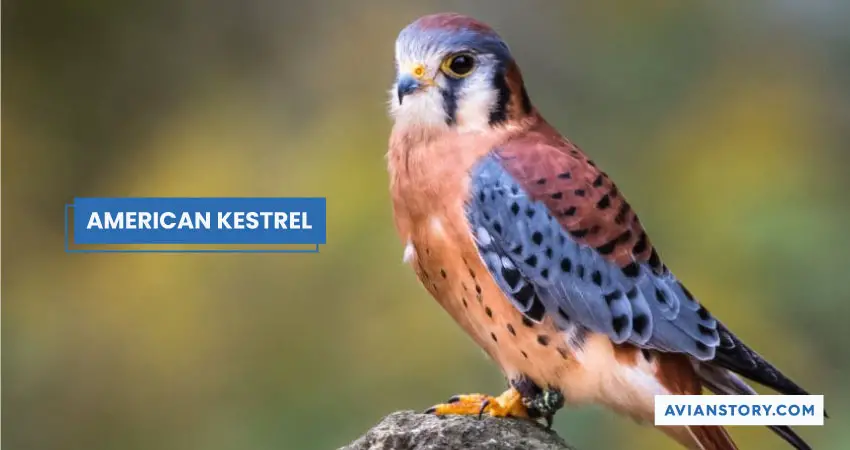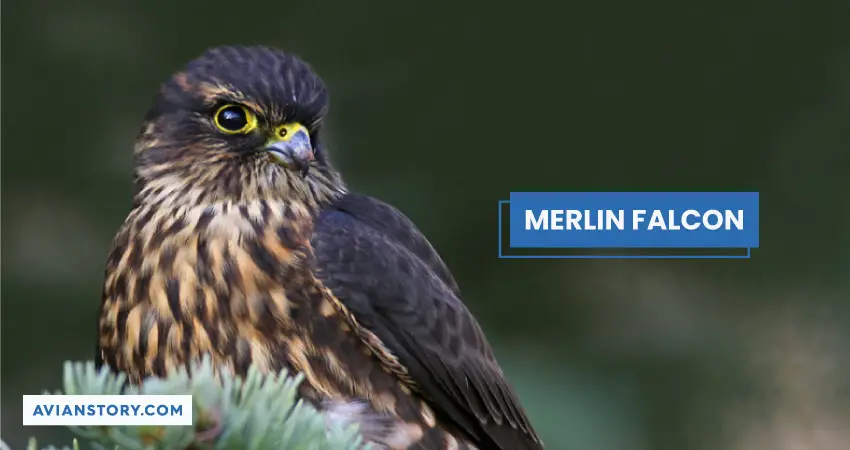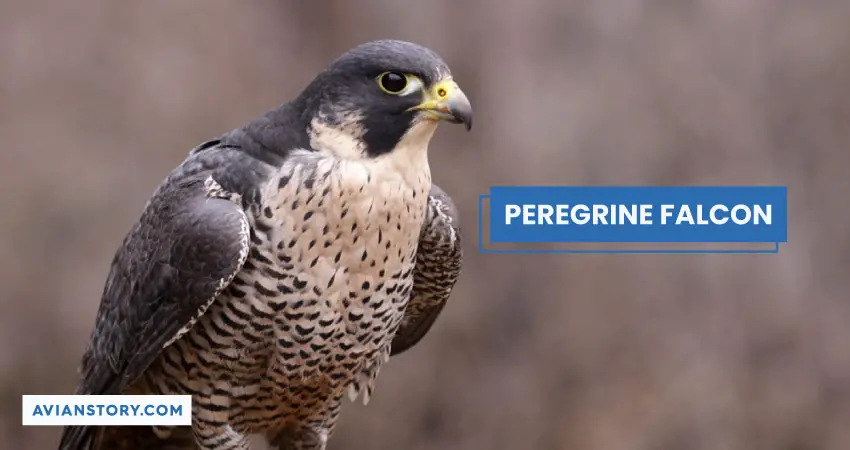3 Species Of Falcons In Indiana
Indiana has to be one of the best places on the earth for spotting the Falcons. There are about 40 species of Falcons in the world. Only 3 of them can be found in Indiana.
Despite the limited number of species that you can find in Indiana, it’s always teeming with these birds. No matter where in Indiana you live, there’s always a high chance of spotting a Falcon.
In this article, we’ll discuss the 3 species of Falcons in Indiana in detail, so you know how to distinguish them from one another.
Falcon Species You Can Find in Indiana
| Name | Length | Weight | Wingspan | Scientific Name | Chances of Spotting One in Indiana |
| American Kestrel | 9-12 inches | 2.8-5.8 oz. | 20-24 inches | Falco sparverius | High |
| Merlin | 9.4-11.8 in | 5.6-8.5 oz | 20.9-26.8 in | Falco columbarius | Low |
| Peregrine Falcon | 14.2-19.3 in | 18.7-56.4 oz | 39.4-43.3 in | Falco peregrinus | High |
1. American Kestrel

- Length: 9-12 inches
- Weight: 2.8-5.8 oz.
- Wingspan: 20-24 inches
Commonly Found In
The American Kestrel can be found throughout the year in most of the states of the US. This is true for states other than some Southern states. In Indiana, American Kestrels can be found commonly.
Behavior or Characteristics
Despite being so available, American Kestrels are hard to spot. The reason behind this is actually their size. They are no bigger than the average American Robin, and the largest of them can be up to only 12 inches.
While they’re smaller than most other Falcon species, they’re no worse at hunting. In fact, they’re so fierce that they often defeat predators larger than them.
Despite their capability, they prefer living off of smaller preys. Their diet mainly consists of bugs such as cicadas, grasshoppers, dragonflies, moths, and even spiders. When they’re not eating insects, they may go for lizards, bats, frogs, mice, or small birds such as songbirds.
These are rather easy to spot due to their size, but their colors are unique too. Their heads are small, and the crown has a bluish-grey color which is more grey than blue.
Their body is brown with small dots of black. The wings and the tails are black. Females look a bit different. Their wings are brown with vertical streaks of black. Unlike males, that have a brown chest, females have white ones.
Kestrels have a distinct sound to their calls. Another characteristic of their call is that they do so repeatedly. In most cases, they can be spotted and identified with their call only.
In urban regions, they can often be found on power lines or power poles. They prefer staying in warm places as their preys tend to hibernate in the winter. This forces these birds to migrate to warmer climates.
Fun Fact or Interesting Fact
- They’re the smallest falcons found in North America
- These birds tend to hunt in family, which is not commonly seen in other species of Falcons.
- They’re one of the few species of Falcons in whose case the male can be distinguished from the female just by their outlook.
2. Merlin

- Length: 9.4-11.8 in
- Weight: 5.6-8.5 oz
- Wingspan: 20.9-26.8 in
Commonly Found In
Merlin Falcons are found throughout the United States are they are quite common. The climate of North America Favors these birds, which is why they’re found throughout the continent.
However, they aren’t found year-wide throughout the continent. There are some northern states of the US and some Canadian regions where they can be found throughout the year.
For the rest of the continent, they’re found seasonally. In Indiana, they’re found during the season of migration. These birds prefer spending their winter in the southern regions of the continent, and they migrate to the northern regions of Canada during the summer.
However, the chances of finding Merlin falcons in Indiana is rather high because the shrublands, grasslands, parks, and riverine climate is highly preferred by these birds.
Behavior or Characteristics
Merlin Falcons are relatively smaller in size compared to other falcons, but they’re bigger than American Kestrels. They mainly feed on small birds such as sandpipers, sparrows, and shorebirds. Also, they are aggressive predators who happen to be extremely fast.
This allows Merlin falcons to prey on fast and agile birds. Their attack strategy is very simple. They chase their prey across the horizon or push them from below so they would try to reach higher. This tires their prey out at some point, and that is when the Merlin catches up.
In certain cases, Merlin falcons tend to pair up while hunting. This is mainly seen when they’re hunting a flock of birds, as hunting in pairs increases the success rate.
Merlin falcons are rather easy to identify. They have a stout and short body, and their head looks large compared to their body and is a bit square-like.
Their wings, chest, as well as belly, are streaked. The combination usually has a dark and a light color, and they’re usually shades of brown. Some of them may have white patches as well. There’s no visible difference between the male and female Merlin falcons.
Back in the early 20th century, Merlin falcons were becoming extinct. However, they’ve been restored recently with the combined effort of the government and different animal right activism agencies.
Although they’re easy to identify, they’re tough to spot, as Merlin Falcons are always on the run behind some sparrow or other bird. When they aren’t hunting, they are usually perched on the top of a tall tree. This makes them very hard to spot.
The best way to spot a Merlin would be to look for them in grasslands. Look for relatively smaller trees where they might perch.
Fun Fact or Interesting Fact
- They often team up to hunt a large flock of birds
- Merlin falcons prefer taking over other’s nests instead of building their own
- The Merlin is much heavier than Kestrels despite their similar size
- They have a short lifespan; the oldest living Merlin was almost 12 years old when it passed away.
3. Peregrine Falcon

- Length: 14.2-19.3 in
- Weight: 18.7-56.4 oz
- Wingspan: 39.4-43.3 in
Commonly Found In
Peregrine falcons can be found on every continent other than Antarctica, and they’re quite common in Indiana. These falcons prefer spending the summer in the northern regions of Canada.
They’re found throughout the year in some of the desert regions of the US. In the rest of the states, they’re found when they migrate.
Behavior or Characteristics
These falcons aren’t too large, but they can be considered crow-sized. However, their wingspan is considerably large, and the largest Peregrine Falcons can spread up to 110 cm.
They are rather beautiful looking. These birds have a bright yellow beak that’s complemented by greyish-blue feathers. Their crown, back, wings, and tail are blue, and their chests are white with streaks of blue.
What makes Peregrine Falcons easier to spot is that there’s no difference between how male and female falcons look. However, juveniles can be brown, making it difficult to identify them.
These are super-fast creatures. While diving, they can reach up to 390 kmph, which allows them to catch even the smallest and fastest preys. Their dives are called stoops. The falcons living in urban areas mainly feed on pigeons. In wilder environments, they feed on other birds and sometimes bats and rodents too.
One interesting fact about their anatomy is their lungs are supposed to burst due to the excessively high speed they travel at. However, there’s a bump on their nose that protects them from fast airflow.
The main nesting places of these falcons include cliff faces. Their nests can be found on even the steepest cliffs. While they’re capable of making their own nests, sometimes they tend to occupy nests left by large birds such as eagles or owls.
Peregrine Falcons get their name from their nature. The word Peregrine means wanderer. These falcons tend to explore and wander around the world, which is why they can be found almost everywhere.
Fun Fact or Interesting Fact
- Nests on steep cliffs
- Can dive at a blazing speed of 390 km/h
- There’s a dome-shaped bump on their nose that protects them from high-speed airflow
- There’s almost no difference between how males and females look
Conclusion
As you can see, spotting the Falcons in Indiana isn’t a tough job. Among the 3 types that are found in Indiana, you can spot two very easily. However, spotting a Merlin Falcon might be a tad bit difficult.
We recommend starting off with Kestrels and Peregrines. After gathering some experience, it’ll become easier for you to spot Merlin Falcons as well!
Falcons Found in Other States:

